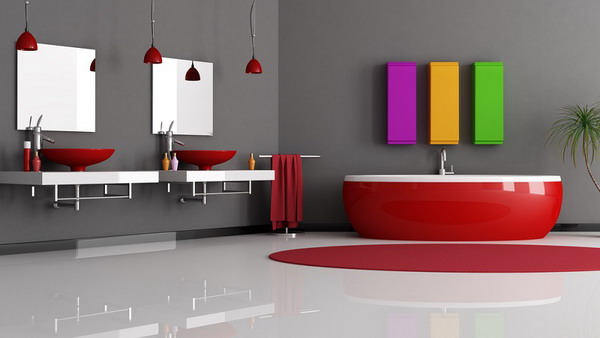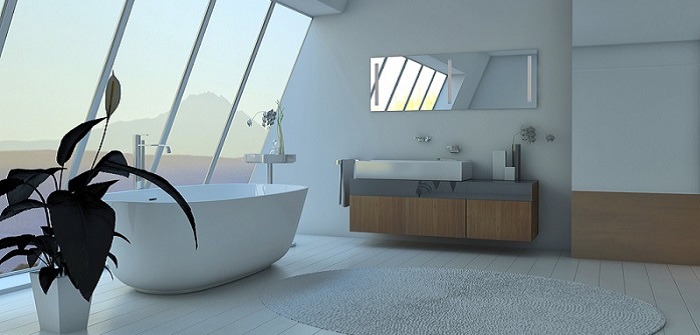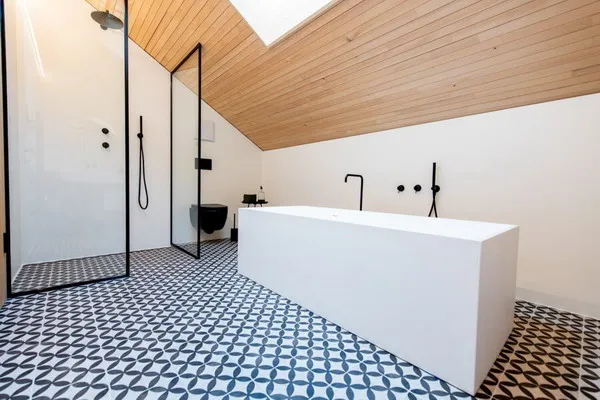 The bathroom is a sanctuary for everyone. The functional wet room is increasingly becoming a wellness stamp. Even the smallest rooms today offer many options for individual bathroom design.
The bathroom is a sanctuary for everyone. The functional wet room is increasingly becoming a wellness stamp. Even the smallest rooms today offer many options for individual bathroom design.
Bathroom design used to be pure luxury
Even in the 1970s, not every household had its own bathroom. Wet rooms in multi-family houses were often used by several families. Statistically speaking, only every household has really had its own bathroom since the 1990s – although the trend is now towards several bathrooms in one house. Having your own bathroom was a real luxury until well into the 20th century.
Whoever had one was usually so thankful that he only thought about the bathroom design to a limited extent. However, individuality is now the key. The simple guest toilet often already offers the functionality that was previously expected from fully used bathrooms. The design is no longer just about the standard ceramic goods from the hardware store.
Individual design with and without tiles, with shower or bath tub (and beyond) is a matter of course today, like the question of how to design the living room. Consumer electronics or even seating groups find their place more and more often in the previously purely practical wet rooms. Often, more space is given as part of modernizing bathroom design. A wall is removed – and you already have space for the realization of all ideas. The urge to get more comfort from the time in the bathroom is understandable.
After all, the German spends an average of almost 40 minutes on personal hygiene – with this value taking into account both the quick shower in five minutes and the extensive use of the bath for two hours. It is striking that according to statistics, the East Germans spend more time in the damp walls – this may also be due to the fact that the modern and more beautiful bathrooms have now been installed in many places. After the reunification, many private individuals took advantage of the new opportunities offered by western hardware store shopping paradises and of course a great deal was invested in new buildings.
Even in the 1970s, not every household had its own bathroom. Wet rooms in multi-family houses were often used by several families.
Today you have more options in bathroom design
Even in the 70s, there were mainly standard goods in the sanitary shops. Standard dimensions, standard colors (who does not remember the bright orange or dull shades of green, which were the pinnacle of change from the usual sanitary white) and fittings, tubs and showers that were more functional than beautiful, satisfied the needs at the time. Today it can (and must) be more. However, desire and reality diverge.
52 percent of Germans have not renovated their bathroom since they first moved into their own home or apartment, and more than 44 percent of all bathrooms will not be renovated in a period of 15 years. A total of four million bathrooms are said to have not been renovated in over 25 years. Especially in families in which several people (often in the morning at the same time) have to share a bathroom, bathroom design also has practical effects. If shower, sink, toilet and other facilities can be used in parallel or even in different bathrooms, without violating the mutual privacy , all the better.
The numbers prove that bathroom design is an important but neglected topic:
- 26 percent of households are unsatisfied with their bathroom design
- Around 6 million households are planning new purchases in the bathroom within the next two years
- 87 percent want functional and functional bathrooms that are easy to maintain
These values speak a clear language: it is time for modern and efficient bathroom design . What options do you have to adapt the guest bathroom, color scheme and bathroom furnishings individually and still keep them functional and easy to maintain? Last but not least, financeability plays an important role. A look at the future also makes sense: Especially in houses that serve as a place of residence in old age, accessibility and age-appropriate equipment should be taken into account when designing the bathroom furnishings.
What options do you have to customize the guest bathroom, color scheme and bathroom furnishings and still keep them functional and easy to maintain?
Basic decisions in bathroom design
For many households, only the classic variant with floor and wall tiles is considered for both the mini bathroom and the family bathroom . After all, it is a damp room that must be hermetically sealed with regard to moisture damage and mold growth. In principle, of course, that is correct. However, the idea that this can only be done with wall tiles is wrong.
In fact, the trend is increasingly towards variants without tiles – or at least without joints. Because grouting is an aesthetic and hygienic limitation that can cause frustration when cleaning and with freedom of design.
Thanks to modern materials, there are some alternatives these days:
- Design floor made of PVC with various decorations
- Cork – traditional building material with high living comfort
- Stone carpet – sounds strange, but is really available in a wide variety of colors and shapes
- Wood – despite prejudices when properly sealed, also ideally suited for damp rooms
- waterproof plastered walls instead of wall tiles
- Cement for modern bathroom design
- Marble for the high demands
- colorful and affordable design options by painting over tiles
- Special wallpaper for bathroom design
In fact, the trend is increasingly towards variants without tiles – or at least without joints. Because grouting is an aesthetic and hygienic limitation that can cause frustration when cleaning and with freedom of design.
How do you get rid of the gap in the bathroom?
Let’s take a closer look at these alternatives. In general, of course, the same care and expertise must always be shown during planning and execution. Although a lot can be learned in the house today using DIY instructions, one should always keep in mind that questions such as tiling and the correct execution of such work mean that mistakes in bathroom design can have expensive consequences.
Improper work can lead to water damage and mold growth – which also leads to questions of liability law in apartment buildings or in rental properties. Nevertheless, do-it-yourselfers should not be put off by doing a lot of things themselves. It is striking that many suggestions for bathroom design today do without the traditional joint. There are both design and practical reasons for this.
Disadvantages of the joint in the bathroom:
- Lattice patterns are constricting in the mini bath
- Joints are difficult to clean
- Joints are often affected by color changes
- Joints are problem areas when it comes to mold growth
- Damaged joints are a gateway for moisture damage
It is striking that many suggestions for bathroom design today do without the traditional joint. There are both design and practical reasons for this.
Alternatives to the joint in bathroom design
Many want to do without joints from the outset. However, the wall tiles and floor tiles are not automatically out of the race, because tiles can now also be installed in a bump – analogous to the wallpaper. As with the laying of wooden floors, no joints are left between the elements. They are only available in the form of silicone expansion joints on the edge. This gives you the advantages of simply cleaning tiles without having to accept the disadvantages of the joint. Overall, the bathroom looks quieter and larger without the typical joint grid.
Smooth surfaces are easier to clean, and there is no wear on the edges of the edges, as does the accumulation of dirt between the joints. However, this procedure is only recommended for relatively large-format tiles. They also have to be cut to an exact size. Similar effects can be achieved with less effort if other materials are installed on the walls or simply plastered.
Water-resistant plaster, which is specially designed for bathroom design, also offers a largely free color design and can later be painted over or painted relatively easily. The surfaces offer individual structures and colors, feel very different from the usual tiles and can even be attached to old tile walls. We would also like to highlight some of the other alternatives.
Design floors for bathroom design are PVC elements with a carrier layer.
Design floor made of PVC
In design floors for bathrooms design is PVC elements, which are provided with a carrier layer. A decorative layer is glued to this (similar to laminate). In this way, all possible surfaces can be depicted inexpensively, from stone to wood to metal. The decor is protected with a transparent and easy-care protective seal. Such floors are very thin and can therefore also be used in older rooms for renovation without any problems.
Bathroom renovation with cork
Cork is a natural raw material that, when processed correctly, is very durable and, above all, warm to the feet. Many people find this extremely pleasant, especially if they do not have underfloor heating that could heat up their old tiles. However, it is important to lay them properly, including sealing and edge protection, so that the water cannot penetrate under the covering.
Stone carpets are modern and original
With so-called stone carpets you can implement a very individual bathroom design. These are real stones that have been cast into a bed made of acrylic or resin. Depending on the nature of the stones, there are different design options . The surfaces, colors and grain sizes are particularly popular for wall cladding. However, the wall or floor must be properly primed before laying.
Few people considered wood in the bathroom as wall covering or flooring. But why actually?
Wood has no place in the bathroom? That was once
Wooden surfaces in damp rooms do not have a good reputation. Although wooden ceilings were also modern in bathroom design in the 80s and 90s , they were often not well prepared for the wet conditions and therefore caused many problems. Few people considered wood in the bathroom as wall covering or flooring. But why actually?
Ships made of wood have sailed our oceans for centuries. Thanks to modern sealing and sealing methods, this building material can now also be used in the bathroom without any problems. However, professional laying is all the more important to avoid swelling or other problems. In particular, the edges must be given an absolutely watertight seal.
As already listed, there are other materials that are suitable for wall cladding and / or as flooring in the guest bathroom as well as in the main bathroom of the house.
Conclusion: Many alternatives make bathroom design easier today
As already listed, there are other materials that are suitable for wall cladding and / or as flooring in the guest bathroom as well as in the main bathroom of the house. Cement is an extremely popular building material, which is often used in combination with special bathroom plaster. Both variants offer design freedom that make the usual tile mirror superfluous. Resin can also be smoothed out on walls.
Another new trend is the bathroom wallpaper . Of course, these are special wallpapers that are suitable for use in the bathroom and are just as easy to maintain as tiles or other surfaces. A tip at the end : If you can’t or don’t want to spend a lot of money in your hand, you should take a look at the color scheme. Many surfaces (including tiles) can easily be painted over with special paints and varnishes.


